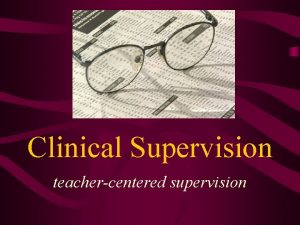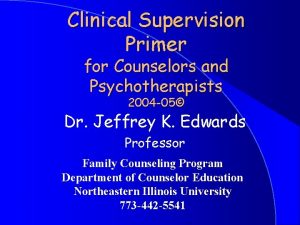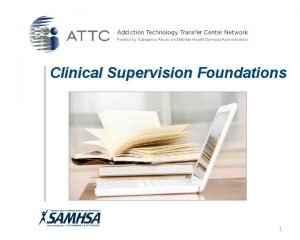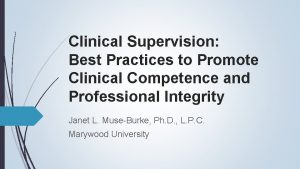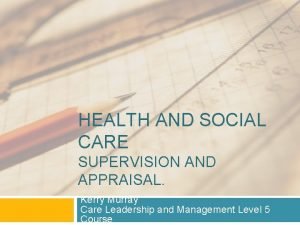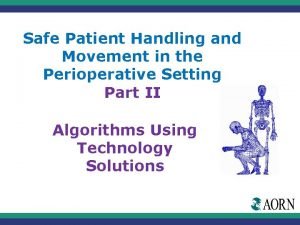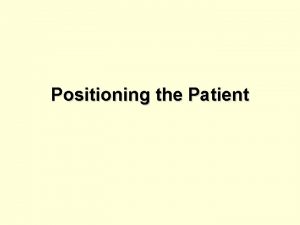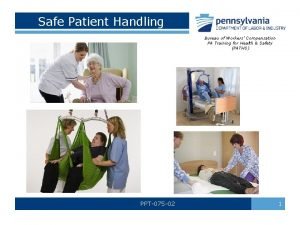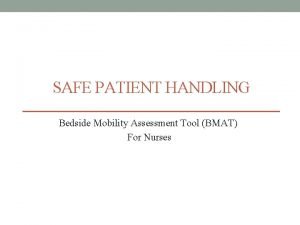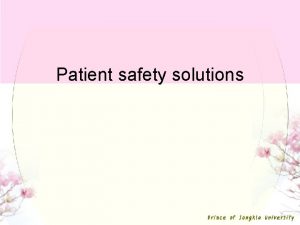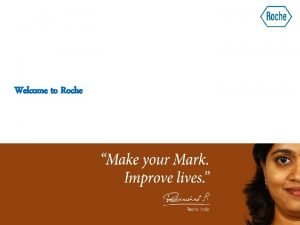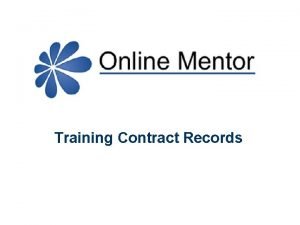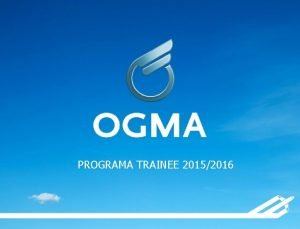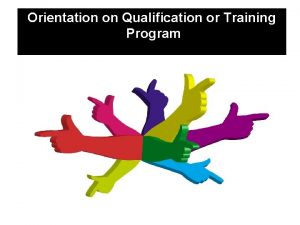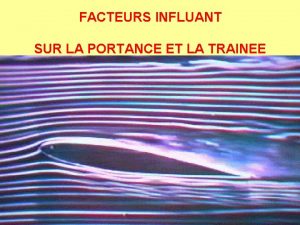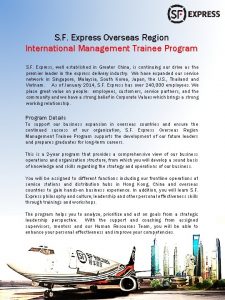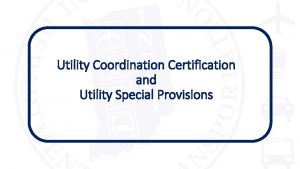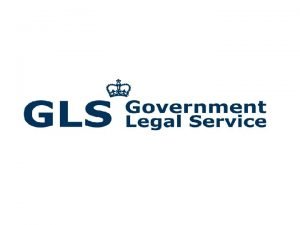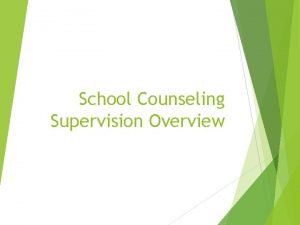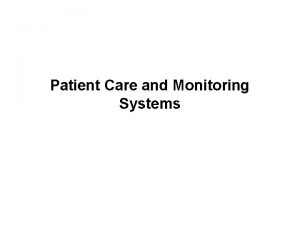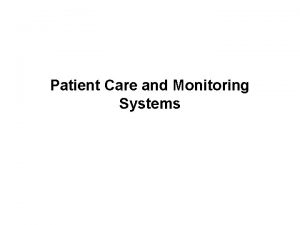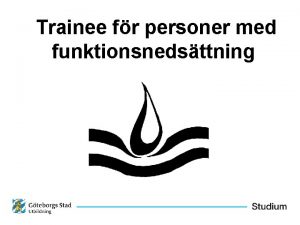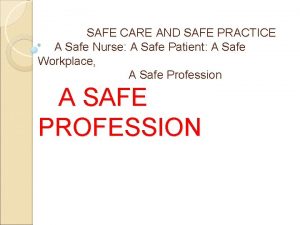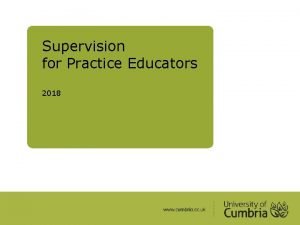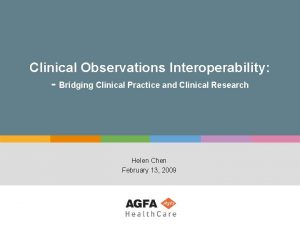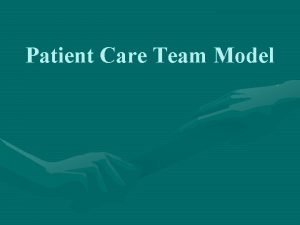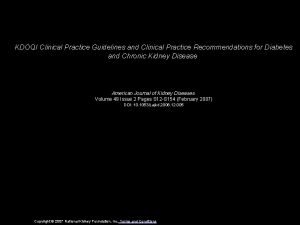Clinical Supervision Safe trainee practice Safe patient care


























- Slides: 26

Clinical Supervision: Safe trainee practice Safe patient care Gavin Anderson Deputy Foundation School Director NYEC

• What are the attributes of a good clinical supervisor • Educational Environment

What makes a good CS? • • • Knowledge Skills Behaviours Motivation Opportunity • If they don’t have it can we train them? ? ?

� Academy of Medical Educators Framework

Named clinical supervisor • ‘A trainer who is responsible for overseeing a specified trainee’s clinical work for a placement in a clinical environment and is appropriately trained to do so. • He or she will provide constructive feedback during that placement, and inform the decision about whether the trainee should progress to the next stage of their training at the end of that placement and/or series of placements. ’

Clinical Supervision • Not just workplace assessment training • Not just teaching • Clinical supervision includes – ensuring the safety of the trainee and patient in the course of clinical care – as well as giving feedback on performance, both informally and through appraisal

Clinical Supervision Service Issues • Nature of clinical supervision will vary between speciality el w ey m e • International Medical graduates on Ti • Benefits for clinical managers Quality; reduced errors More effective and efficient resource use Faster proficiency of skills and independence Managing poor performance M • • nt pe ls Tr ai ni ng In some areas trainees may be working with minimal supervision Trainees performing only at appropriate level Induction Time for effective supervision Handover & – – –

Clinical Supervision • Ed the Su u s c pe at am D m ay rv ion e or to is a as io l e d n im a po y e rt ve an n t? the characteristics…. Helpful supervisory behaviours – giving direct guidance on clinical work, linking theory and practice, engaging in joint problem-solving and offering feedback, reassurance and providing role models. • Ineffective supervisory behaviours – Rigidity, low empathy; failure to offer support; failure to follow supervisees’ concerns; not teaching, being indirect and intolerant and emphasizing evaluation and negative aspects. Good interpersonal skills ot • N – involving trainees in patient care, negotiation and assertiveness skills, counselling skills; appraisal skills; self-awareness, warmth, empathy, respect for others, listening skills, expressing one’s own emotions appropriately, offering support; being positive; having enthusiasm. • Clinical competence – being seen as a good clinician and having up-to-date theoretical and clinical Knowledge • Teaching skills – offering opportunities to carry out procedures; giving direction, giving feedback, having knowledge of teaching resources, knowledge of certification requirements; individualizing the teaching approach; being available and having evaluation skills. • *AMEE Guide No. 27: Effective educational and clinical supervision. Sue Kilminster ; David Cottrell ; Janet Grant ; Brian Jolly (2007).

Clinical Supervision training for all • Consultants who have any contact with trainees, e. g. “sessional supervisors” etc. • Other trainees. Already the largest direct support. Peer Support. • Selected other healthcare workers…. most are fairly generic skills A challenge, but crucial to success!

Clinical supervision is at the sharp end of post graduate education • Program Director • Educational Supervision • Clinical Supervision • Managing multiple trainees, workplaces to promote high quality training in LEP. QC. • Educational Supervision, planning and monitoring training and workplace, career guidance. • Patient safety, quality care, workplace support and assessment and feedback.

HEE YH Educational Supervisors Online Course

BUT! • Remember the other qualities we need in clinical supervisors…. . • Minimum extras… – – Check understanding of e-learning Localisation/speciality specification Calibration/standard setting for assessments Effective feedback (and practicing under supervision) • QM – Clinical Supervision

When? • Training Grades – At entry to programme – Part of educational induction – Major change in seniority – FY 2/CT 1 – Entry to ST 3 • Non-training grade – New consultant/Trust – Recognition of problems – Revalidation of workplaces – Before SPAs can be given over to training – Repeated how often? ? ?

Environment

Educational Environment • “it is difficult to define the training environment – is it a single training programme within a region, an institution, a team or a combination of all of these? ” – Themes from the Quality Assurance Review Workshops June 2012 GMC • • Rota, rest breaks, unsocial hours Ability to access training opportunities, informal & structured, local vs regional Trust and HEE admin support Workplace, team working, ethos and morale of extended team, service pressures, physical environment





Requirements • R 1. 7 Organisations must make sure there are enough staff members who are suitably qualified, so that learners have appropriate clinical supervision, working patterns and workload, for patients to receive care that is safe and of a good standard, while creating the required learning opportunities.

Requirements • R 1. 8 Organisations must make sure that learners have an appropriate level of clinical supervision at all times by an experienced and competent supervisor, who can advise or attend as needed. The level of supervision must fit the individual learner’s competence, confidence and experience. The support and clinical supervision must be clearly outlined to the learner and the supervisor.

Requirements • Foundation doctors must at all times have on-site access to a senior colleague who is suitably qualified to deal with problems that may arise during the session. • Medical students on placement must be supervised, with closer supervision when they are at lower levels of competence.

Further Highlights • Organisations must make sure that work undertaken by doctors in training provides learning opportunities and feedback on performance, and gives an appropriate breadth of clinical experience. • Organisations must make sure learners have an induction in preparation for each placement • Doctors in training must have uninterrupted protected time for learning

Requirements • Organisations must have the capacity, resources and facilities to deliver safe and relevant learning opportunities, clinical supervision and practical experiences for learners required by their curriculum or training programme and to provide the required educational supervision and support.

� QM of the Educational Environment • Source of Intel – – – – GMC survey Deanery QM visits Deanery EOP form Untoward clinical incidents and their investigation Local DME/FTPD/ES knowledge Comment by trainees at specific feedback sessions School meetings (including trainee reps)

Questions?
 Hip fracture clinical care standard
Hip fracture clinical care standard Goals for clinical supervision
Goals for clinical supervision Clinical supervision questions
Clinical supervision questions Clinical supervision foundations ii
Clinical supervision foundations ii Stages of clinical supervision
Stages of clinical supervision Best practices in clinical supervision
Best practices in clinical supervision Primary secondary and tertiary health care
Primary secondary and tertiary health care Supervision and appraisal in health and social care
Supervision and appraisal in health and social care Patient 2 patient
Patient 2 patient Safe patient handling algorithms
Safe patient handling algorithms Recumbent positioning
Recumbent positioning Sims position
Sims position Safe patient handling
Safe patient handling Bmat mobility assessment
Bmat mobility assessment Safe patient transfers
Safe patient transfers Patient safety solutions
Patient safety solutions Roche trainee programm
Roche trainee programm Training records example
Training records example Sra training contract
Sra training contract Ogma recrutamento
Ogma recrutamento Role of cbt trainee
Role of cbt trainee Trainee portance
Trainee portance Trainee european commission
Trainee european commission 360 degree reflection
360 degree reflection Sf express management trainee
Sf express management trainee Indot special provisions
Indot special provisions Government legal trainee scheme application process
Government legal trainee scheme application process

